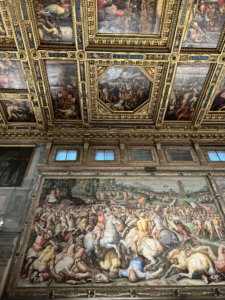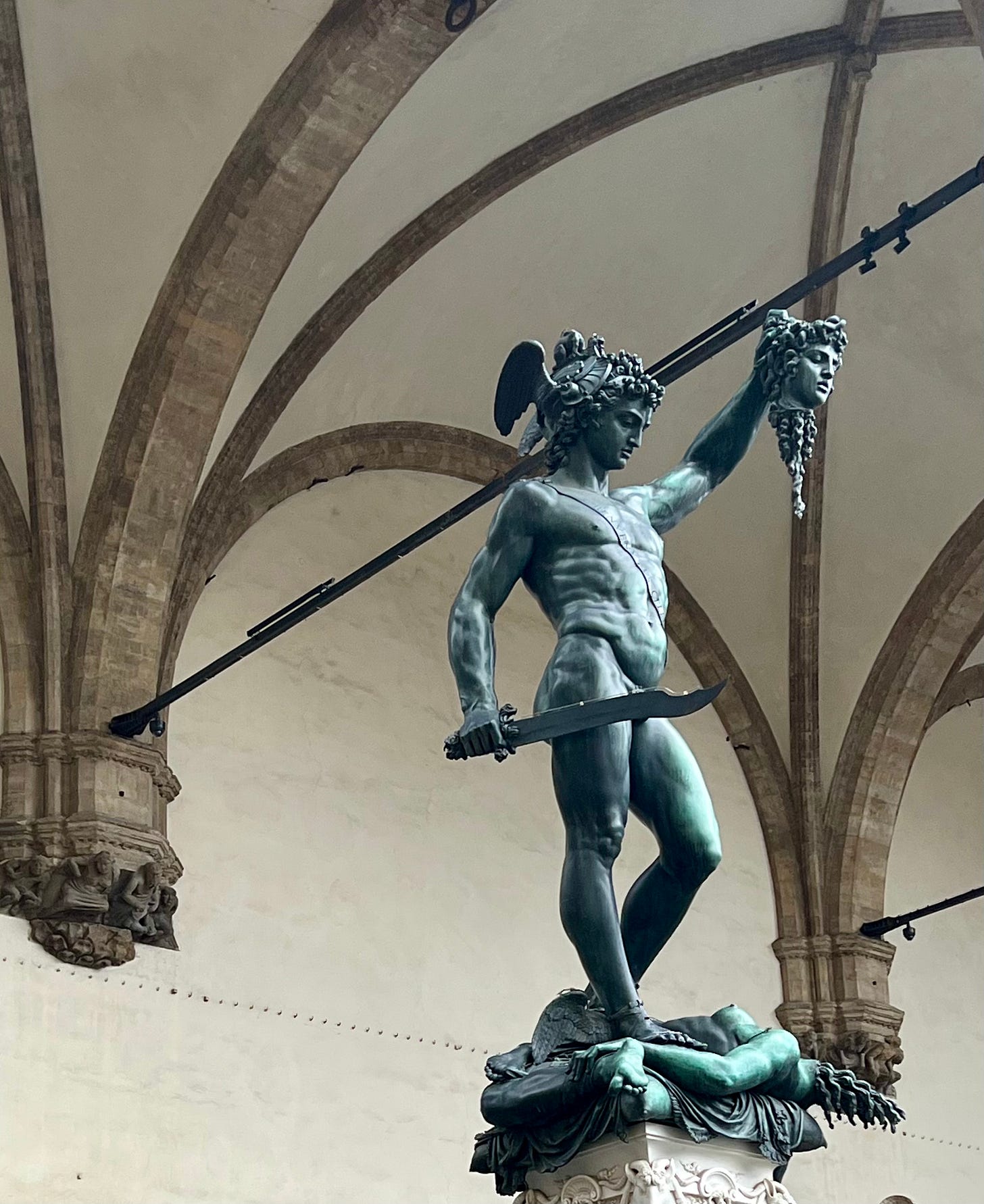This episode is about how the world stopped spinning for a few moments while I stared at the frescoes in the Hall of the Five Hundred in Florence.
Links:
- Into Tuscany upcoming tours.
- Rifrullo bar in the San Niccolò neighborhood in Florence.
- Agata Chrzanowska, PhD, art historian and professional tour guide in Florence.
- Palazzo Vecchio museum, piazza della Signoria, Florence.
Full episode transcript:

A few weeks ago I was in Florence to visit my family, and to research upcoming tours. One morning I needed some time by myself, so I decided to visit a museum in downtown Florence.
When I’m at home in Oregon I spend a lot of time outdoors, but I miss real art museums.
Of course, there is no better place than Florence for that.
My mother kindly offered to take care of my toddler for a few hours while I went to the Palazzo Vecchio Museum, which is in Piazza della Signoria. I parked the car in my usual secret spot in the San Niccolò neighborhood, and I had a lovely cappuccino at the Rifrullo bar. I walked under my umbrella in the pouring rain through an almost empty town. February is one of the only months of the year when you can actually walk across Ponte Vecchio without being swallowed up in the flood of tourists. There weren’t even many Florentines, since it was a rainy Sunday morning. As soon as it starts drizzling, Florentines stay indoors.
I walked across the Uffizi gallery and once I was in the Piazza della Signoria, I spent a few moments staring at the statue of Perseus with the head of Medusa by Benvenuto Cellini. I always think of a conversation I had with the art historian, Agata Chrzanowska.
She told me that whenever she feels sad or unhappy, she goes to see that statue. It’s her painkiller. If you can ever see it in person, you’ll understand what she meant. There is something magical in the way the light reflects on this bronze sculpture, off the lines of the muscles. It’s utterly perfect.

So I crossed the Piazza, and went into the museum. There was no line at the ticket desk –Florence in February! I crossed the courtyard and climbed the stone stairs to the second floor, to the Salone dei Cinquecento, the Hall of the Five Hundred. It’s huge–23 meters long and 18 meters high—with walls and ceiling frescoed by Vasari. The few people who shared the space with me were too awestruck to speak – the place was silent.
I was staring at the frescoes, taking in the details of the horses and their expressions, and then it was like the world stopped spinning. My usually swirling thoughts froze. I looked up at the ceiling, with heightened senses. The silence felt like a warm blanket. I felt the cold, slightly humid air on my skin. My breathing slowed and deepened, and I felt my chest rising and falling.
Energy coursed into my body and I couldn’t help smiling. My face flushed. I stayed there for a few minutes, enjoying every second. When I finally moved to the next room, the sensation quickly dissipated, leaving me with a feeling of quiet contentment.
There’s a name for what happened to me, for what happens to people when they visit Florence. It’s called Stendhal Syndrome.
This syndrome was first described in 1967 by the Italian psychiatrist Graziella Magherini. She worked at a psychiatric hospital in downtown Florence and noticed that hundreds of tourists were checking in the emergency room with the same symptoms : palpitations, dizziness, and a sense of euphoria. She realized that all these symptoms were linked to the psychological impact of the artworks that are everywhere in Florence.
She called it Stendahl Syndrome because after doing the Grand Tour of Italy in 1817, the French writer Stendahl wrote in Rome, Naples and Florence that while visiting the Basilica of Santa Croce in Florence he “was in a sort of ecstasy, absorbed in the contemplation of sublime beauty. He had palpitations of the heart and walked with fear of falling.”
While other academics have questioned whether the syndrome is a real psychiatric disorder, subsequent research has demonstrated that experiencing art increases the level of serotonin in the brain and can trigger intense pleasure.
And that’s why I travel, visit new places, and go to art museums. I’m looking for that feeling, that moment when I experience something that transcends myself and the world stops for a few moments.
Everyone should come to Florence, because there are so many places where you can have your own Stendhal moment.
